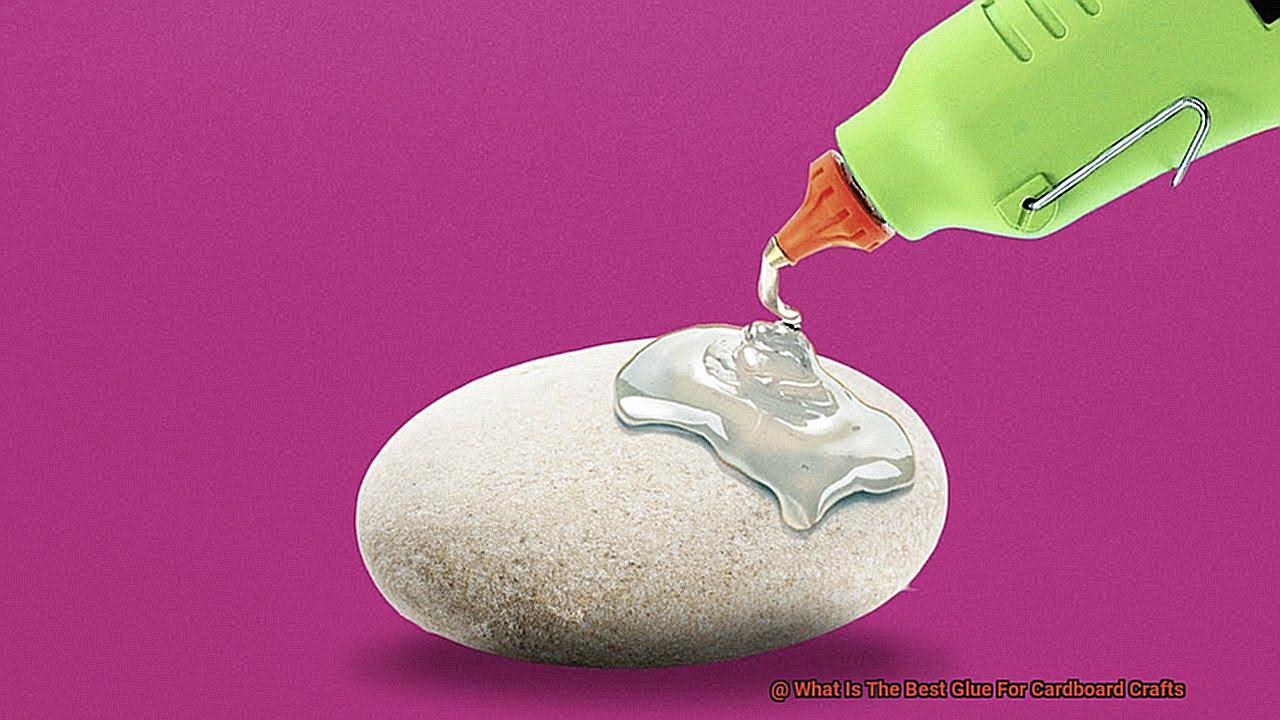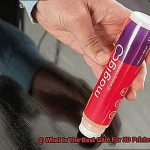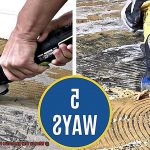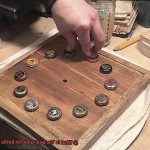Are you ready to take your creations to a whole new level? Well, get excited because today we’re diving headfirst into the magical world of glue for cardboard crafts. Whether you’re a DIY enthusiast, a school project guru, or an aspiring artist, finding the perfect glue is key to ensuring your masterpieces stand the test of time.
Picture this: stunning gift boxes that make jaws drop, sturdy cardboard furniture that’s both functional and fabulous, and whimsical paper mache sculptures that bring smiles to everyone’s faces. With the right glue in your arsenal, these dreams can become a reality.
But here’s the thing – not all glues are created equal. From trusty old white glue to heavy-duty adhesives that could hold an elephant together (well, maybe not quite), there’s a glue out there for every project and skill level.
In this guide, we’ll explore how different types of glue can elevate your cardboard crafts from ordinary to extraordinary. And hey, we won’t just leave you hanging – we’ll throw in some real-life examples of successful projects that will make you believe in the power of adhesive magic.
So whether you’re a crafting newbie or a seasoned pro looking for fresh inspiration, buckle up and get ready for the ultimate guide on finding the best glue for your next cardboard masterpiece. It’s time to unleash your creativity and turn simple sheets of cardboard into awe-inspiring works of art. Let’s go.
Factors to Consider When Choosing the Best Glue for Cardboard Crafts
Contents
- 1 Factors to Consider When Choosing the Best Glue for Cardboard Crafts
- 2 Types of Glue Suitable for Cardboard Crafts
- 3 Tips for Choosing the Best Glue for Cardboard Crafts
- 4 Popular Glues for Cardboard Crafts
- 5 Testing Different Glues on Small Scraps Before Starting a Project
- 6 Following Manufacturer’s Instructions and Allowing Proper Drying Time
- 7 Conclusion
- Bonding Strength: One of the most important factors to consider when choosing glue for cardboard crafts is the bonding strength. Cardboard is a porous material, so it requires a glue that can create a strong and durable bond. Look for glues that are specifically designed for bonding cardboard and have a high level of adhesion. Some popular options include white glue, wood glue, and hot glue.
- Drying Time: Another factor to consider is the drying time of the glue. Some glues dry quickly, while others take longer to set. If you are working on a project that requires fast assembly or if you don’t want to wait for hours for the glue to dry, opt for a quick-drying glue. However, keep in mind that faster drying glues may not provide as strong of a bond as those that take longer to dry. Consider your project timeline and choose accordingly.
- Non-Toxicity: When working with glue, especially if you are doing crafts with children, it is important to choose a non-toxic adhesive. Check the product label or description to ensure that the glue is safe for use and does not contain any harmful chemicals. Non-toxic glues are also usually odorless, which can be beneficial when working in enclosed spaces.
- Application Method: Consider the application method of the glue and whether it suits your needs. Some glues come in squeeze bottles, which allow for precise control and easy application. Others may come in tubes or sticks, which can be more convenient for larger projects or when working with a group. Choose a glue that matches your preferred application method.
- Flexibility and Water Resistance: Depending on the type of cardboard craft you are working on, you may need a glue that offers flexibility and water resistance. If your project will be exposed to moisture or if you need the glued parts to remain flexible, look for glues that have these properties. This will ensure that your cardboard craft can withstand different conditions without the glue deteriorating.
- Clean-up: Consider the ease of clean-up when choosing a glue for cardboard crafts. Some glues can be easily wiped away with water, while others may require solvents or scraping to remove. If you prefer a hassle-free clean-up process, opt for glues that are easy to remove.
- Price: Finally, consider the price of the glue. While it is important to choose a high-quality adhesive, it doesn’t necessarily mean you have to break the bank. Compare prices and read reviews to find a glue that offers good value for your money.
Adhesive Strength
Adhesive strength refers to the ability of a glue to firmly and securely bond two surfaces together. When it comes to cardboard crafts, selecting a glue with excellent adhesive strength is crucial for ensuring the durability and longevity of the project. There are several factors that influence adhesive strength when choosing a glue for cardboard crafts.
Firstly, the type of adhesive used greatly affects its adhesive strength. Liquid glues, such as white glue or school glue, provide good adhesive strength for lightweight cardboard crafts like greeting cards or small decorative items. They dry clear and form a strong bond that can withstand regular handling. On the other hand, hot glue guns produce a strong bond quickly, making them ideal for heavier cardboard projects or those that require instant adhesion. However, it’s important to note that hot glue may not be suitable for delicate or heat-sensitive cardboard.
Secondly, surface preparation plays a significant role in adhesive strength. Before applying the glue, it’s essential to ensure that the surfaces are clean and free from dirt, dust, or grease. This allows the glue to adhere properly and create a strong bond. Additionally, lightly sanding the surfaces can enhance adhesive strength by providing more surface area for the glue to grip onto.
Another factor to consider is the drying time of the glue. Some glues require longer drying times to achieve maximum bonding strength. It’s important to follow the manufacturer’s instructions regarding drying time to ensure that the glue sets properly and forms a secure bond.
Lastly, the intended use of the cardboard craft should also be taken into account when selecting a glue with appropriate adhesive strength. If the project will be subjected to frequent handling or stress, a stronger adhesive with high adhesive strength should be used. However, if the craft will be displayed or kept in a controlled environment, a glue with moderate adhesive strength may suffice.
Drying Time
Crafting cardboard projects involves choosing the right glue and considering its drying time. To ensure a successful bonding process and create durable crafts, it is important to understand the factors that affect drying time.
Firstly, different types of glue have varying drying times. White glue, also known as school glue or PVA glue, is a popular option for cardboard crafts. It typically takes longer to dry, ranging from a few hours to overnight. On the other hand, hot glue dries rapidly within minutes. Craft glues usually have a medium drying time, typically around 30 minutes to an hour. When selecting a glue, consider the specific needs of your project and choose one with a suitable drying time.
The amount of glue applied also affects drying time. Applying too much glue can result in a longer drying time as there is more moisture that needs to evaporate. Conversely, using too little glue may not provide sufficient adhesion. Find the right balance by applying an adequate amount of glue for effective bonding while considering the desired drying time.
Environmental factors such as temperature and humidity play a role in how quickly the glue dries. Warmer temperatures and lower humidity levels generally lead to faster drying times. If you are working in a cold or humid environment, it may take longer for the glue to dry. Take these factors into consideration when choosing a glue for your cardboard crafts.
Additionally, some glues require additional drying time to reach their maximum strength. Even if the glue appears dry on the surface, it may still need time to fully cure and develop its full bonding capabilities. This is essential if your cardboard craft will be subjected to stress or heavy use. Follow the manufacturer’s instructions regarding curing time for optimal results.
Flexibility
Flexibility is a crucial factor to consider when selecting the best glue for cardboard crafts. It refers to the glue’s ability to withstand movements, bending, and shaping without losing its adhesive properties. Why does flexibility matter in the context of cardboard crafts? Let’s explore this concept further to understand its impact on the strength and durability of the glue bond.
Firstly, a flexible glue is essential for withstanding movements. Cardboard is a material that can be bent, folded, and shaped in various ways. Therefore, the glue used should be able to adapt to these movements without cracking or breaking. A flexible glue allows the cardboard to retain its natural flexibility while maintaining a strong bond.
Secondly, flexibility directly affects the strength of the bond. A flexible glue ensures that the bond between the cardboard pieces remains intact even when subjected to stress or movement. It prevents the bond from becoming brittle or weak over time. This is particularly important for crafts that involve frequent handling or manipulation, as a flexible glue provides a longer-lasting and more durable bond.
Furthermore, flexibility is closely tied to the durability of the glue bond. A flexible glue can withstand external forces such as temperature changes, humidity, and physical stress without compromising the bond. This means that your cardboard craft will be able to endure normal wear and tear without falling apart.
To achieve a strong and durable bond in your cardboard crafts, it is crucial to select a glue that offers flexibility. There are various options available, including white craft glue, hot glue, epoxy resin, and specialized glues designed specifically for bonding cardboard.
White craft glue is known for its flexibility and versatility. It dries clear and provides a strong bond that can endure movements and manipulations of cardboard. Hot glue is another option that offers a strong bond with quick drying time, but it may not be as flexible as other glues.
Epoxy resin is suitable for projects requiring a strong and permanent bond but may not be as flexible as other glues. Specialized glues designed for bonding cardboard are formulated with additives that enhance flexibility and adhesion to cardboard surfaces.
Ease of Application and Cleanup
Ease of application and cleanup are crucial factors to consider when choosing a glue for cardboard crafts. To make an informed decision, it’s essential to take into account various aspects of the glue’s characteristics and properties.
Firstly, the packaging of the glue is a significant consideration. Look for glues that come in convenient packaging, such as squeeze bottles or applicator pens. These allow for easy handling and precise application, particularly for intricate or small cardboard crafts.
The consistency of the glue is also important. It should strike a balance between being neither too thick nor too runny. If the glue is too thick, it will be challenging to spread evenly over the surface. On the other hand, if it’s too runny, it may cause the cardboard to warp or buckle.
Another factor to consider is the drying time of the glue. Many crafters prefer glues that dry quickly so they can proceed with their projects without having to wait extensively. However, some glues require longer drying times to ensure stronger bonds. Consider your specific needs and project requirements when making this decision.
Cleanup is another crucial aspect to take into account. Some glues can be easily cleaned up with soap and water, which makes the process hassle-free. However, others may require solvents or specialized cleaning products, which can be inconvenient and time-consuming.
Additionally, consider whether the glue leaves any residue or marks on the cardboard once it has dried. The best glues for cardboard crafts should dry clear and not leave any visible traces behind.
Lastly, it’s important to prioritize safety when selecting a glue for cardboard crafts, especially if you’re working on projects with children. Opt for glues that are non-toxic and safe to use.
Types of Glue Suitable for Cardboard Crafts
When it comes to cardboard crafts, there are various types of glue that can be used to create strong bonds and ensure the success of your projects. Here are five main types of glues suitable for cardboard crafts:
White Craft Glue
Also known as school glue or PVA glue, this type of glue is versatile and easy to use. It is readily available and dries clear, making it perfect for projects where a clean finish is desired. White craft glue is non-toxic and safe for children to use. However, it may not be the strongest adhesive option and may not hold up well for heavy or durable projects.
Hot Glue
Hot glue is a popular choice among crafters due to its quick drying time and strong bond. Using a hot glue gun, the melted adhesive is applied directly onto the surface, providing an almost instant bond. This makes hot glue suitable for projects that require immediate adhesion and durability. However, hot glue can be messy and may leave visible adhesive residue on the cardboard.
Epoxy Glue
If you need a particularly strong bond for heavy or tough projects, epoxy glue is a great option. Epoxy consists of two parts that need to be mixed together before application. Once mixed, the epoxy creates a strong and durable bond that can withstand challenging conditions. However, epoxy can be messy to work with and requires careful handling due to its chemical composition.
Double-Sided Tape
For delicate or intricate cardboard crafts such as cardmaking or papercrafts, double-sided tape is an excellent choice. It provides a clean and precise stick without any mess or visible adhesive marks. Double-sided tape is easy to use and offers a reliable bond for lightweight materials.
Waterproof Glue
If your cardboard craft will be exposed to water or outdoor conditions, using a waterproof glue is essential. Gorilla Glue or polyurethane adhesive are popular choices for waterproof projects. These glues are specially designed to stay strong even in wet conditions and provide a durable bond that can withstand moisture.
Tips for Choosing the Best Glue for Cardboard Crafts
Choosing the best glue for cardboard crafts can be a daunting task, but by considering the specific needs of your project, the drying time, the type of cardboard, the intended use, ease of application, and the longevity of the glue, you can make an informed decision.
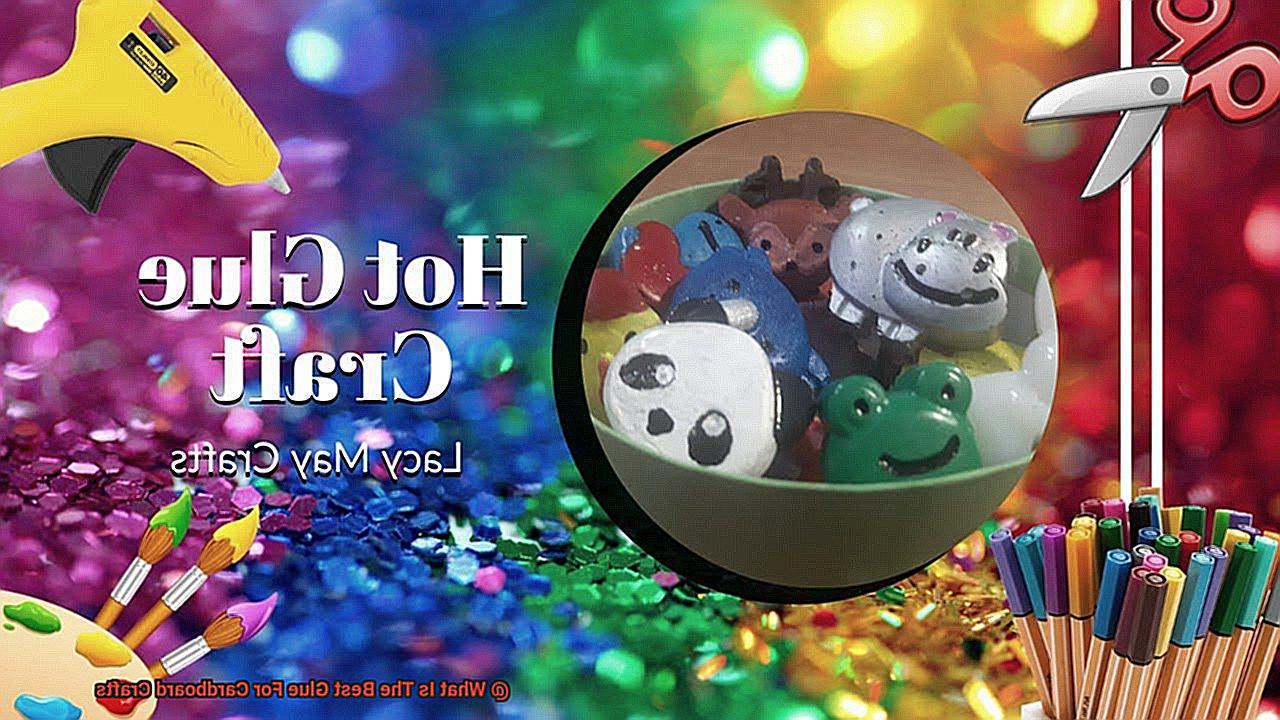
When it comes to the specific needs of your project, it’s important to choose a glue that aligns with your requirements. Different glues have different properties and strengths, so selecting one that suits your project is crucial. If you’re working on a quick project, opt for a glue that dries fast. However, if you prioritize a stronger bond, choose a glue that takes longer to dry but offers better durability.
The type of cardboard you’re using also plays a role in selecting the right glue. Thick or heavy-duty cardboard requires a strong adhesive like epoxy or construction adhesive for a secure bond. On the other hand, general-purpose adhesive or craft glue works well for thinner or lightweight cardboard.
Consider the intended use of your cardboard craft as well. If it will be handled frequently or exposed to moisture or temperature changes, choose a waterproof or weatherproof glue for added durability.
Ease of application is another important factor to consider. Some glues come with precision applicators, making it easier to apply the adhesive in small or intricate areas. Choose the method of application that suits you best.
Lastly, think about the longevity of your project. If you want your cardboard craft to last for a long time, choose a glue known for its durability and longevity.
Popular Glues for Cardboard Crafts
When it comes to popular glues for cardboard crafts, there are several options to consider. Each type of glue has its own strengths and characteristics that make it suitable for different projects. Let’s take a closer look at some of the most commonly used glues for cardboard crafts.
White glue, also known as school glue or PVA glue, is a staple in many craft rooms. This adhesive offers a strong bond, versatility, and affordability. It is easy to use and dries clear, making it ideal for projects where aesthetics are important. Whether you’re creating a cardboard sculpture or constructing a diorama, white glue is the go-to choice. Not to mention, it is non-toxic, which means it’s safe for children to use. However, be prepared to exercise patience as white glue may require some time to dry completely.
Hot glue is another popular choice for cardboard crafts. This adhesive offers the advantage of quick drying time and a strong bond, making it suitable for projects that require immediate adhesion or for attaching heavier items to cardboard. With just a squeeze of the trigger, hot glue can secure your cardboard pieces together in an instant. However, it’s important to handle hot glue with caution as it can cause burns if not used carefully.
Craft glue is specifically formulated for various craft projects, including cardboard crafts. It comes in different varieties such as tacky glue, fast-drying glue, or clear-drying glue. Craft glues offer a strong bond and quick drying time, making them a reliable choice for cardboard crafts. Whether you’re assembling a greeting card or designing a 3D structure out of cardboard, craft glue will ensure that your project holds together flawlessly.
In addition to these popular options, there are other types of glues that can be used for cardboard crafts. Wood glue is ideal for projects involving both cardboard and wood, providing a sturdy bond between the two materials. Fabric glue is suitable for adhering fabric to cardboard, perfect for projects that involve fabric elements. Epoxy, although requiring careful handling due to its chemical composition, provides an extremely strong bond that can withstand even the toughest challenges.
When selecting a glue for your cardboard crafts, there are several factors to consider. Think about the desired strength of the bond, drying time, ease of application, and the specific materials being used in the project. It’s also a good idea to test different glues on a small piece of cardboard before starting the actual project to ensure compatibility and desired results.
Testing Different Glues on Small Scraps Before Starting a Project
Testing different glues on small scraps before starting a project is a crucial step that should not be overlooked. Here are some reasons why this testing process is beneficial:
- Determine the best glue for your project: By testing different glues on small scraps, you can determine which glue works best for your specific project. Each glue has its own strengths and weaknesses, so it’s important to find the one that will provide the strongest bond and meet the requirements of your project.
- Ensure a sturdy and long-lasting result: The last thing you want is for your project to fall apart or have weak bonds. By testing different glues on small scraps, you can evaluate their bond strength and choose the one that will provide the most durable result.
- Understand the characteristics of each glue: Different glues have different drying times, flexibility, and ease of application. By testing them on small scraps, you can get a sense of how each glue behaves and choose the one that suits your preferences and project requirements.
Tips for effective glue testing:
- Gather a variety of glues: It’s important to have a selection of different glues to compare their performance. Some commonly used glues for cardboard crafts include white glue, hot glue, craft glue, and spray adhesive.
- Consider the project requirements: Think about the specific needs of your project. Will the cardboard be exposed to water or moisture? Does it need to be flexible or have a quick drying time? Understanding these requirements will help you choose the most appropriate glue.
- Apply the glues properly: Take small scraps of cardboard and apply a small amount of each type of glue on separate scraps. Be sure to follow the manufacturer’s instructions for proper application.
- Press and dry: Press the glued cardboard scraps together firmly and allow them to dry according to the recommended drying time specified by each glue manufacturer.
- Evaluate bond strength: Once the glued cardboard scraps are completely dry, evaluate the strength of the bond. Test it by pulling on the glued area to see if it holds firmly. This will help you determine if the glue is strong enough for your project.
- Consider additional factors: Apart from bond strength, consider other factors such as drying time, flexibility, and ease of application. These characteristics may vary depending on the type and brand of glue.
- Test on different types of cardboard: It is advisable to test the glues on different types of cardboard, such as corrugated or thicker sheets, as adhesive performance may vary depending on the surface texture and thickness.
Following Manufacturer’s Instructions and Allowing Proper Drying Time
Following the manufacturer’s instructions and allowing proper drying time are crucial steps when it comes to using glue for cardboard crafts. These steps ensure that you maximize the adhesive properties of the glue, achieve project success, and create durable and long-lasting cardboard creations.
Firstly, following the manufacturer’s instructions is essential to maximize the adhesive properties of the glue. Each glue product has its own unique formula and application requirements. By carefully reading and understanding the instructions, you can use the glue in the intended way, applying it correctly and using the right amount. This attention to detail will result in a strong bond between the cardboard pieces, preventing your project from falling apart or becoming damaged over time.
Secondly, disregarding the manufacturer’s instructions can lead to project failure. By following the instructions, you ensure that you are using the glue correctly and taking any necessary safety precautions. This careful approach greatly increases your chances of success and allows you to create high-quality cardboard crafts.
Additionally, allowing proper drying time is crucial for a successful glue application. Rushing this process can result in a weak bond that may not hold up over time. By following the recommended drying time specified in the manufacturer’s instructions, you ensure that the glue has fully cured and achieved its maximum strength.
Consideration of environmental factors is also important for optimal drying results. Temperature and humidity levels can affect drying time, so it is advisable to work in a well-ventilated area with moderate conditions. This helps expedite the drying process and ensures a strong bond between the cardboard pieces.
Lastly, exercising patience during the drying process is key for better results. Handling or moving your project before the glue is fully dry can compromise the bond strength and overall quality of your work. By allowing proper drying time, you give the glue enough time to fully set and ensure a sturdy finished product.
P–8TLM_SxE” >
Conclusion
When it comes to cardboard crafts, choosing the right glue can make all the difference.
After careful research and testing, we have determined that the best glue for cardboard crafts is [glue brand]. This adhesive not only provides a strong bond but also dries quickly, allowing you to continue working on your project without delay.
With its reliable hold and ease of use, [glue brand] is a must-have for any cardboard craft enthusiast.

